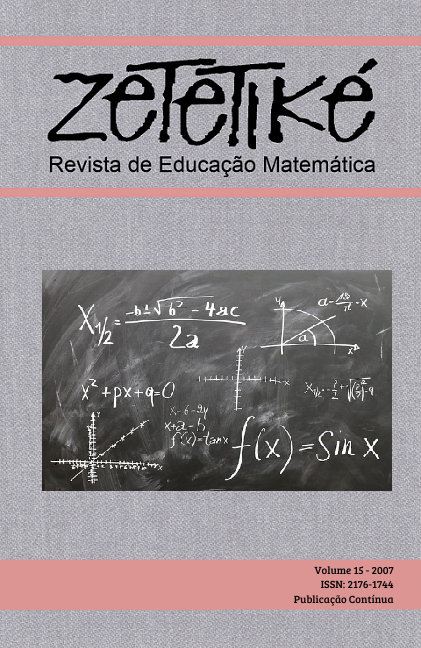Abstract
The formulation of mathematical problems is a fundamental activity
in the development of the mathematics, moreover, it possess a great didactic
potential. Consequently, the research presented had as general objective the description how students formulate mathematical problems starting from
different types of texts and, as specific objectives, the analysis of structural
alterations happened in the formulated problems in relation to the shut or
standard problems as well to investigate if students noticed the meaning,
expressed in the intertextual relationship, that is common to eleven texts. To
reach these objectives, the formulation of eleven mathematical problems,
starting from eleven different types of texts was proposed. Those texts were
introduced to the students at eleven different sessions. The results obtained
showed that the experiences lived deeply by the students disclose the
beginning of a process of understanding on the formulation of problems and
have established a relation between the Mathematics and the thinking and
critical context. This comprehensive process may contribute for the
development of the creativity and the citizenship.
References
BAKHTIN, M. Estética da criação verbal. São Paulo: Martins Fontes, 1992.
BARNETT, J.C. et al. Problemas nos livros didácticos: complementando-os e entendendo-os. In: KRULIK, S. & REYS, R. E. (Org.). A resolução de problemas na Matemática escolar. Tradução: Hygino H. Domingues e Olga Corbo. São Paulo: Atual, 1998.
BUTTS, T. Formulando problemas adequadamente. In: KRULIK, S. & REYS, R. E. (Org.). A resolução de problemas na Matemática escolar. Tradução: Hygino H. Domingues e Olga Corbo. São Paulo: Atual, 1998.
CAMPOS, E., CURY, M.Z.F. Fontes Primárias: saberes em movimento. Revista da Faculdade de Educação da USP, São Paulo, vol. 23, no.1-2, jan./dez. 1997., -SP.
CÂNDIDO, P.T. Comunicação em Matemática. In: SMOLE, K.S. & DINIZ, M.I. (Org.). Ler, escrever e resolver problemas: habilidades básicas para aprender Matemática. Porto Alegre: Artmed Editora, 2001.
CHICA, C. Por que formular problemas? In: SMOLE, K.S. &DINIZ, M.I. (Org.) Ler, escrever e resolver problemas: habilidades básicas para aprender Matemática. Porto Alegre: Artmed Editora, 2001.
COTES, P. Cinema no vestibular. Revista Época, Editora Globo, Edição 273-11/08/2003.
DANTE, L. R. Tudo é Matemática. São Paulo: Ática, 2004. DAVIS, P., & HERSH, R. A experiência Matemática. Lisboa: Gradiva, 1995.
D’ AMBRÓSIO, U. Por que se ensina Matemática? Disponível em: Acesso em: 03 de setembro de 2003.
FERREIRA, M.G-L. Atlas geográfico. São Paulo: Moderna, 1998, p.31- 32.
FREIRE, P. Pedagogia da Autonomia: saberes necessários à prática educativa. São Paulo: Paz e Terra, 1997.
GUELLI, O. Matemática. Série Brasil. Ensino Médio/Volume Único. São Paulo: Ática, 2003.
GUIMARÃES, G., OLIVEIRA, I.A.F.G. A resolução de problemas de proporção simples através de desenhos. Anais do IV Encontro Pernambucano de Educação Matemática (EPEM). Recife: UFPE, 1999. (disquete).
HOSMER, P.C. Students can write their own problems. Arithmetic Teacher, 34, dez. 1986.
KRISTEVA, J. Introdução à semanálise. Trad. Lúcia Helena Ferraz. São Paulo: Perspectiva, 1974. 199p.
LIMA, E.L. e Problemuinhas. Revista do Professor de Matemática, 12. SBM. p.55. (CD-ROM), 2002.
LYOTARD, J. F. O pós-moderno. Tradução: Ricardo Correia Barbosa. 3. ed. Rio de Janeiro: José Olímpio, 1990.
MAREUSE, M.G. Relação Arte, Ciência e novas tecnologias na Pós-Modernidade. Disponível em: http:// www.montessorinet.com.br/sumário.htm.(2004). Acesso em 01 de maio de 2004.
MEC. Parâmetros Curriculares Nacionais (PCN) para o Ensino Médio: Orientações complementares aos Parâmetros Curriculares Nacionais. Ciências da Natureza, Matemática e suas tecnologias / Secretaria de Educação Tecnológica – Brasília: MEC; SEMTEC, 2002.
MEDEIROS, K.M., O contrato didáctico e a resolução de problemas matemáticos em sala de aula. Educação Matemática em Revista, SBEM, nº9/10, 2001.
NUNES, T et al. Introdução à Educação Matemática. São Paulo: PROEM, 2001.
PAVANELLO, R.M. Educação Matemática e Criactividade. A Educação Matemática em Revista, SBEM, nº 3. 2º sem. 1994.
PLUVINAGE, F. Didactique de la resolution de problemes. Petit – x, nº 32, p. 5-24, 1992-1993.
SINGH, S. O último teorema de Fermat. 2. ed. Tradução deCalife, J.L. Rio de Janeiro: Recobre, 1998.
WILDE, S. Learning to Write About Mathematics. Arithmetic Teacher. Vol. 38, nº 6, fev. 1991. Tradução: Alexandre da S. Mello – CAEM – IME –USP, 1994.

This work is licensed under a Creative Commons Attribution-NonCommercial-NoDerivatives 4.0 International License.
Copyright (c) 2014 Zetetiké: Revista de Educação Matemática

